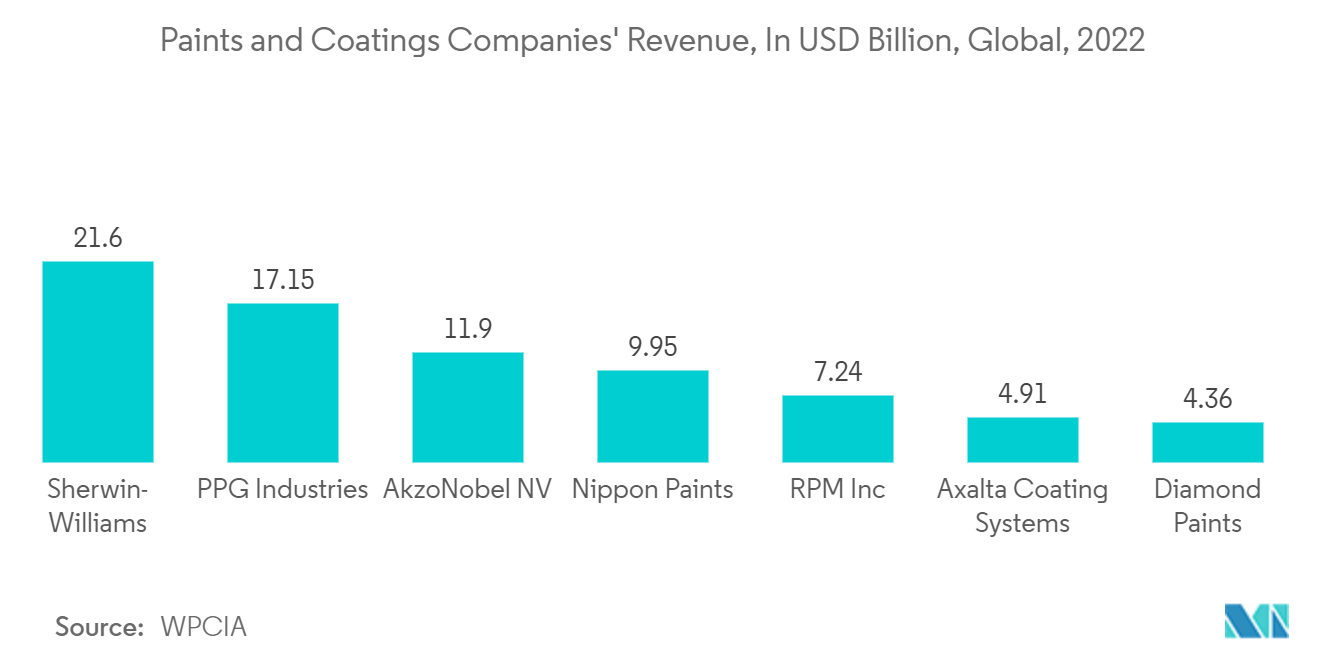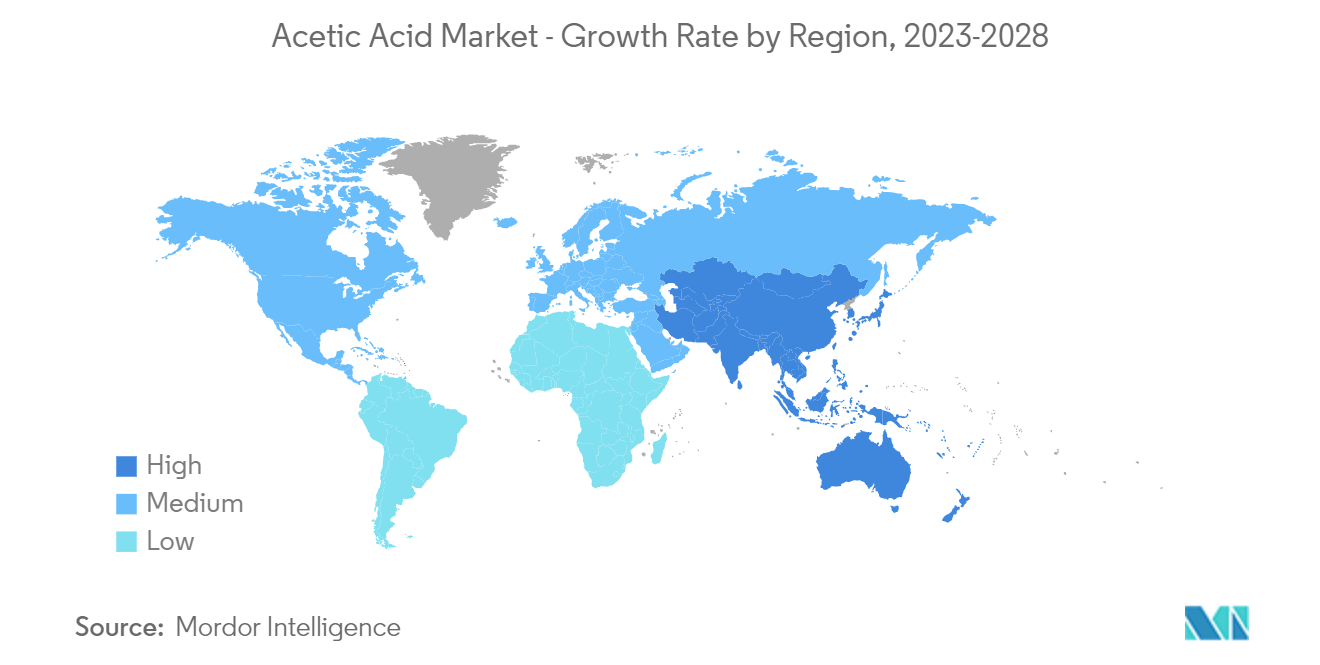Market Trends of Acetic Acid Industry
Increasing Applications in the Adhesives, Paints, and Coatings Industry
- Acetic acid, as well as its ester derivatives, such as ethyl acetate, butyl acetate, and vinyl acetate, are widely used in making adhesives, paints, and coatings. The acidic nature of acetic acid and its ability to dissolve polar and nonpolar compounds make it a useful ingredient in adhesives, paints, and coatings.
- Vinyl acetate monomer (VAM) is used in producing water-based paints, adhesives, waterproofing coatings, and paper and paperboard coatings. PTA-based polyesters and polyamides are also used in hot-melt adhesives. PTA is even used in paints as a carrier.
- The World's Paint and Coatings Industry Association estimated that in 2022, global sales of paints and coatings exceeded USD 180 billion. At the same time, the paints and coatings industry is anticipated to register a CAGR of about 3% by 2027.
- The value of the North American market was 33.92 billion USD in 2022, while the value of the European market was 42.37 billion USD, according to the association's annual report. It was considered that each of these locations would grow independently due to an increase in residential renovation projects in Canada, Germany, and the United States.
- According to the American Coatings Association (Coatings Tech), the paint and coatings industry in the United States is expected to reach USD 28.06 billion by 2022. Similarly, in terms of volume, the paint and coatings industry is estimated to reach 1,416 million gallons by 2022. This is likely to enhance the demand for acetic acid from the paints and coatings sector in the country.
- There are numerous significant paint companies in Europe, which is home to the continent's four largest mainland economies: Germany, France, Italy, and Spain. Europe's largest market for paints and coatings is in Germany. It is home to over 300 coatings, paint, and printing ink production firms.
- The key firms in the paints and coatings sector were also included in the WPCIA report, along with their market shares. It was anticipated that Sherwin-Williams (USD 21.64 billion) dominated the market, followed by PPG Industries (USD 17.15 billion), AkzoNobel NV (USD 11.9 billion), and Nippon Paints (USD 9.95 billion).
- Owing to all these factors, the rising investments in different industries will increase the demand for adhesives, paints, and coatings from all around the world and thus positively influence the acetic acid market.

Asia-Pacific Region to Dominate the Market
- Asia-Pacific is the largest consumer of acetic acid in the global market. The Asia-Pacific market is anticipated to be the largest market for the adhesives, paints and coatings, food and beverage, and textile industries, owing to its strong industrial base.
- Acetic acid is widely used in greases, coatings, polyesters, and sealants, which have extensive applications in numerous industries, such as electronics, automobiles, textiles, and packaging. The extensive growth in these industries represents one of the major factors driving market growth in the Asia-Pacific region.
- The Asia-Pacific paints and coatings market was estimated to be worth USD 63 billion in 2022, according to the World's Paint and Coatings Industry Association. China dominates the region's market, which has been registering a CAGR of 5.8% over the last few years. In 2022, the Chinese market grew by 5.7%. According to current trends, China's total sales of paints and coatings exceeded USD 45 billion in 2022, giving the country a 78% market share in East Asia.
- According to European Coatings, there are nearly 10,000 coatings manufacturers located in China. Most of the leading global coating manufacturers, such as Nippon Paint, AkzoNobel, Chugoku Marine Paints, PPG Industries, BASF SE, and Axalta Coatings, have their manufacturing bases in China. Paint and coatings companies have been increasing their investments in the country. For instance, in July 2022, BASF expanded its production capacity of automotive refinish coatings in Guangdong Province in South China. The company has an annual capacity of 30,000 metric tons per year.
- According to the Ministry of Economy, Trade, and Industry (Japan), the production volume of synthetic resin paints in Japan amounted to approximately 1.01 million metric tons in 2021, making up an enormous production volume of paints. Overall, the production volume of paints added up to nearly 1.53 million metric tons in 2021, compared to 1.50 million metric tons in the prior year.
- Additionally, in January 2022, India's Ministry of Chemicals and Fertilizers published the quality control orders on acetic acid, aniline, morpholine, and methanol to postpone the implementation dates on them. It covers the specifications and standards of acetic acid production.
- According to the statistics presented by the Ministry of Chemicals and Fertilizers, in India, major chemical production climbed by 5.73% to 43.51 lakh metric tons in 2022-23 (up to July 2022), compared to 41.15 lakh metric tons in the previous year's similar period.
- With the growing global demand for various chemicals, the demand for intermediates, such as acetic acid, from this sector is expected to increase significantly during the forecast period.
- Due to the abovementioned factors, the market for acetic acid in the region is expected to have steady growth during the forecast period.


